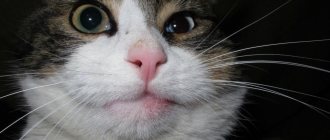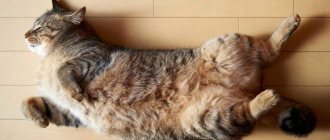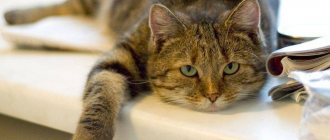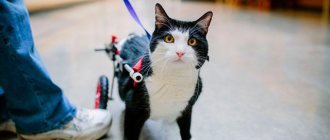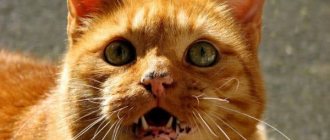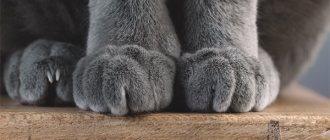Landing mechanism
Experiments with cats falling were carried out two centuries ago by French researchers. They changed the height, released the cat and analyzed its movements. For a long time it was believed that the tail was responsible for landing on four paws, because it was considered a kind of rudder. But later it turned out that even without a tail, the cat always lands on its paws.
© shutterstock
Regardless of the position in which the fall begins, in a very short time the cat's body turns around and aligns itself with the ground. In more detail it looks like this :
- The head turns first, so the cat sees and evaluates the place where it will land;
- then, along with the head, the whole body forms one line;
- she presses her front paws to her head;
- stretches its hind legs as far as possible.
Fast and precise rotation of the body also occurs due to excellent flexibility. Unlike a human, a cat's spine consists of 30 links, which provide its inherent elasticity and grace. The role of a shock absorber in cats is performed by developed, strong paw muscles and soft pads on them. They absorb the impact force during contact with the surface.
This is how you can describe the technique of turning a cat when falling from a height:
By bending the body to create different axes of rotation for the front and back of the body, the cat extends its hind legs and tucks its front legs. She then twists the back of her body to one side and the front to the other. The opposite rotations cancel each other out, and the total torque in the fall remains zero. In this case, the front part turns a little more due to the pressed paws.
Then the cat tucks its hind legs and puts out its front legs, performs a slight twist in the opposite direction, but still - the back and front parts of the body in different directions. This time the back part unfolds more, thanks to the retracted legs.
Depending on the initial position of the body before the fall and its own flexibility, the cat can turn its paws down in one series of movements, or they need to be repeated several times.
Some sources claim that the cat turns around by rotating its tail. Allegedly, the tail rotates in one direction, and the body in the other (again, keeping the initial torque unchanged). But observations have shown that tailless cats are also capable of turning around in the air, which speaks in favor of the technique described above, where a flexible body and legs are involved, and the tail is not used.
What helps cats survive a fall from a height safely is not only the ability to land on their paws, but also the special structure of their paws. Cats' paws are usually long, muscular, and springy. They are able to significantly soften the impact on the ground.
Observing cats helped scientists take a broader look at the laws of mechanics, as well as find useful applications for cat technology in developing techniques for astronauts to move in zero gravity.
Of course, the cat does not perform any complex mathematical calculations at the moment of its fall. She does all these actions intuitively. https://www.site/ This setting reflex begins to appear in kittens at the age of 3-4 weeks, and is fully developed by 7 weeks.
Does height matter?
Despite the fact that absolutely every cat has developed instinct, they do not always land on their paws when they fall. In this case, there is a certain obstacle due to which the natural physiological process is disrupted. This may be due to the height being too small or too high :
- If a cat falls from 20-30 cm from the ground, it simply will not have enough time to roll over onto its paws. As a result, she will fall flat.
- Long distances have a different effect. The excellent abilities of the vestibular apparatus, thanks to which the cat navigates in space and evaluates all chances, are not able to withstand a strong blow.
A cat's body weight is significantly less than its body area - this feature allows it to group correctly. In humans, this ratio is significantly lower, which accounts for the inability to develop such a skill. In addition to inappropriate height, obstacles to proper landing in cats can be obesity, blindness, problems with the musculoskeletal system, etc.
© shutterstock
Other Amazing Abilities
In addition to the ability to fall correctly, representatives of the cat family demonstrate other amazing abilities.
Ability to fit in any container
The cat easily places its body in small boxes, vases, dishes and other containers unsuitable for such use. Moreover, the unnatural position of the body does not cause any discomfort to the animal.
Treatment of hosts
Cats are true natural healers. They always subtly sense the condition of their owners and try to lie down on the place that hurts. Their positive impact on the psychological state of people leaves no doubt.
Premonition of Trouble
Numerous cases confirm the fact that cats are able to anticipate natural disasters, catastrophes that threaten misfortune to a person. Foresight is explained by the subtle intuition inherent in these animals and well-developed hearing. Thus, during the Second World War, people under fire often relied on the behavior of their pets. The approaching bombers were indicated by a change in the cats' behavior: they began to worry and look for cover. In addition, a strong energetic connection is often established between the cat and the owner, as a result of which the animal senses the illness and approaching death of the person.
Why can cats get injured when falling?
Sometimes cats don't have enough time to roll over in the right direction. The minimum height required for a cat to turn around is 30 cm. If the cat does not turn around, it can land on its back or side - places that are completely unsuitable for this. Thus, falls from a small height can be even more traumatic than from a height of several meters.
Another reason for accidents is that nature has endowed the cat with such a useful reflex for living in its natural habitat, but in a modern city this does not always save. A metropolis is too much of a challenge for a cat! Apartment buildings are much taller than trees, and you can’t catch on plastic and metal like you can on a branch.
In addition, cats that spend all their time in an apartment usually lead a sedentary lifestyle and are often even overweight, which sharply reduces their natural ability to survive. All other things being equal, where a wild, muscular, fit cat gets off with a slight fright, “Garfield” risks being crushed into a cake!
Therefore, let's not delude ourselves that a cat ALWAYS lands on its paws, but let's think about the safety of our furry friends. If you have a cat, then there should be nets on the windows, and the balcony should be glazed or always closed!
Photo of a black cat in flight Darren Sethe
Time-lapse photo of a cat falling sciencefocus.com, Oxford University press
› Make sure that cats really always land on their feet and find out what physical laws contribute to this.
- Tasks:
› Detect known physical phenomena, objects and patterns of a cat when it falls.
› Turn to external sources, study the opinions of many scientists.
› Study the physical laws that help a cat when it falls.
- Hypothesis:
› Cats land successfully on their feet due to their skeletal structure.
- Research stages:
1) Turn to external sources and understand why a cat always lands on its paws from a physics point of view.
2) Look at experiments done by people.
3) Summarize the information and draw a conclusion.
Why is this happening?
For forward motion, it has been indisputably proven: no matter what processes occur inside a flying brick, its center of gravity continues to move forward at the same speed and in the same direction, as if nothing were happening inside the core. The explosion of a projectile does not change the path and speed of the center of gravity: the projectile explodes into millions of fragments, but the center of gravity of all fragments follows the same path until not a single fragment falls to the ground.
For a long time it was believed that the same rule applies to the rotation of a body around an axis. It was believed that by internal efforts alone a body not supported by anything could not turn in space. Meanwhile, the cat, undoubtedly, during the fall somehow manages to turn around so as to fall on all fours. How does she manage to do this?
For example, the following version was proposed: supposedly the cat manages to push off from the support even before the jump begins. The gymnast, jumping from the trapeze, pushes off from it so that his body receives a rotational movement; then, already in the air, he accelerates this rotational movement by curling up into a ball, pressing his arms and legs to his body: this gives him the opportunity to turn over in the air.
It was assumed that the cat does the same.
However, a knacker's experiment (a cat was suspended from the ceiling by four laces by its paws, and then the laces were quickly cut) showed that the cat does not act this way. The cat still managed to fall to her feet...
So, the mystery of the “cat fall” remained unsolved for a long time. The mechanism of the cat's turning has only recently been clarified. A cat has two means of turning its body when falling.
First, the movement of the tail: when a cat, holding its tail at an angle to its body, makes a rotational movement with it, the whole body turns in the opposite direction. The muscles that rotate the tail in one direction at the same time push off from the body and thereby force it to turn in the opposite direction - the law of equality of action is fulfilled. By a series of successive turns of the tail, the cat can turn its body to the desired angle; there is no violation of the laws of mechanics in this.
Secondly, there is another cat trick. When a falling cat turns the front half of its body, the back half turns in the opposite direction by the same angle; if the cat then turns the back half in the same direction, the front half will return back and the cat's body will again take its previous position. No turning is possible under such conditions. But the situation will be different if the cat, when turning, extends and shortens its front and hind legs accordingly. According to the law of areas, a part of the body with outstretched paws should, other things being equal, rotate at a smaller angle than a part of the body with pressed paws. By alternating between stretching and pressing its paws, the cat can achieve the desired turn in the desired direction through a series of body movements.
Let us explain this with a simplified example, dividing each turn into two separate techniques.
The cat technique forced scientists to reconsider a number of axioms of mechanics.
You've probably heard about the paradox - the lower the height of a cat's fall, the more injuries and deaths.
And the opposite is true: the higher a cat falls, the more chances it has to survive. Is it true?
They claim that this is so.
Cats masterfully roll over when falling, but when falling from a small height of 3-5 floors, the cat often simply does not have time to complete all these maneuvers. Accordingly, he falls “unprepared” and does not use all his capabilities. And the force of the impact does its job, limbs are broken, internal organs are injured...
Veterinarians even gave it a name – fall from height syndrome.
Having studied cat falls, we came to the conclusion that most cats fall from heights at night, and the most severe injuries are suffered by cats that fall from the 3rd-5th floor. Positive outcomes occur when falling from higher floors. Much depends on the air currents, the landing surface and the starting position of the cat. From a height of 9-10 floors, cats' chances of a successful outcome decrease.
There is even a cat and butter paradox.
:
Everyone knows that when a cat falls, it always lands on its feet. Why is this happening? Experimenters Alexander Pushnoy and Alexey Ivanchenko explained this phenomenon
:
Results:
As a result of the study, we learned that a cat is helped to land on its paws by its muscles, which rotate the tail in one direction and the body in the other. From the point of view of physics: the law of equality of action helps a cat land on its paws.
Conclusion:
After my observations, I was convinced that cats always land on their paws, but a successful outcome depends on the height from which the cat falls.
Sources:
Cats have many abilities that are beyond the control of humans: they see in the dark, their sense of smell is 14 times sharper, and their hearing is amazingly sensitive. In addition, the specific structure of the body explains why cats land on their feet. No other animal has a similar skill. This phenomenon is their unique gift.
